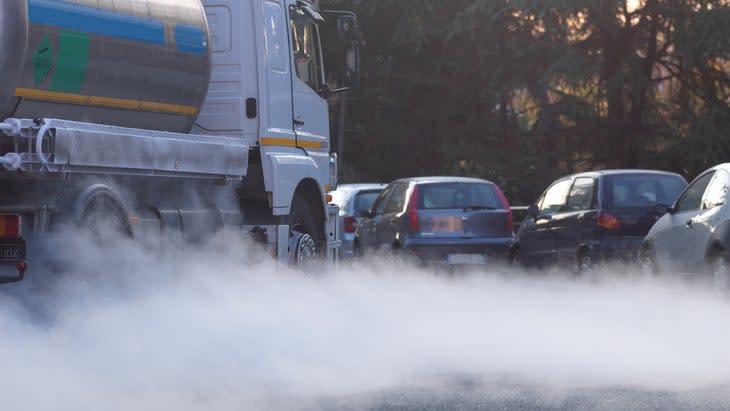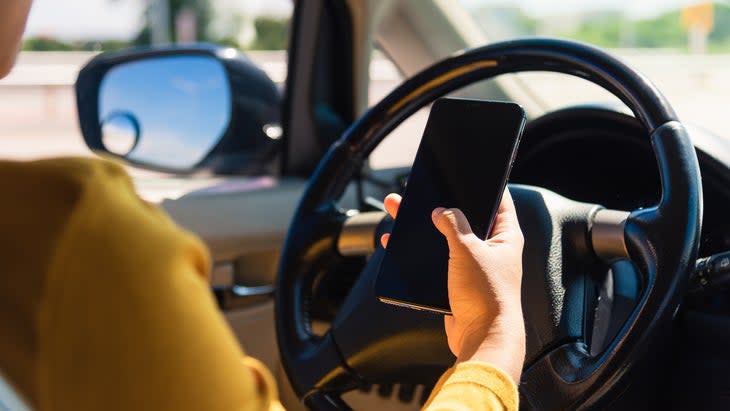Why Idling is Bad for Your Car, Health, Wallet, and the Environment
This article originally appeared on Outside
Doing right by the planet can make you happier, healthier, and--yes--wealthier. Outside's Head of Sustainability, Kristin Hostetter, explores small lifestyle tweaks that can make a big impact. Write to her at climateneutral-ish@outsideinc.com.
Quite literally: idling gets you nowhere. It's a mindless bad habit that we don't even think about, but one that has real implications on our health, our wallets, our vehicles, and our climate crisis. Yet unlike so many bad habits, this one is so easy to break. All we have to do is turn the key.
Ron Zima, founder and CEO of GoGreen Communications, Inc., is a man on a mission to raise awareness about what he calls our idling epidemic. The self-proclaimed "Idle-Free Guy," he teaches fleet operators and municipalities around the U.S. and Canada how to save money and emissions by curbing idling habits. "Forty percent of the average person's vehicle time is spent idling," he says, and it can cost you anywhere from $200 to $1,000 in wasted fuel per year (depending on what you drive).
Why do we idle so much? Zima pins the problem on two things: outdated myths about how engines work and our smartphone obsession with scrolling. "Modern-day cars are engineered to be driven, not idled," he says. "If you're stopped for more than two minutes, you'll actually prolong the life of your car by turning it off."
As for smartphones, Zima says they turn us into mindless zombies. "Go to any school parking lot and you'll see rows of cars filled with well-meaning moms and dads, heads down, scrolling on their phones with the windows up, the AC or heat blasting, and toxic chemicals spewing out their tailpipes," he says. "Our schools have become the location for dirtiest air our kids have to breathe in their lifetimes, and at a very critical time in their physical development."
Why Car Idling Is Bad For Your Health (and Your Kids' Health)
Dr. Patrick Ryan is a professor of pediatrics and environmental health at Cincinnati Children's Hospital Medical Center who studies the effects of traffic-related air pollution on children's health by measuring air pollution at places where children spend time including their homes and schools and simultaneously monitoring children's health impacts.
"What we've found is that just 30 minutes of exposure to ultrafine particles (which is what comes out of the tailpipes of school buses all over the country) kids experience lower lung function," he says. "And if those kids have asthma, symptoms like coughing, shortness of breath are exacerbated."
But the impacts don't stop there. Ryan's research also indicates that long term exposure to these emissions impacts kids' brains, too. "When kids breathe these tiny particles, they can cause an inflammatory response," he says. "In our studies we've shown kids who are exposed to higher levels of air pollution in early childhood have elevated rates of anxiety and depression at age 12. Other studies have also linked air pollution to a decrease in executive function and negative cognitive outcomes."
Idling + Car Pollution: The Toll on the Climate Crisis

The environmental impact of idling cars and trucks is pretty staggering.
According to Argonne National Laboratories which does research for the U.S. Department of Energy, Americans waste 6 billion gallons of fuel each year, just by idling. Zima contends that that number is low and estimates that between the U.S. and Canada, it's more like 8.8 billion gallons. But even taking the more conservative number, that amount of idling generates more than 58 million tons of CO2 emissions, the equivalent car pollution of driving almost 12 million gas-powered passenger vehicles for one year (source: EPA's Greenhouse Gas Equivalencies Calculator).
In April 2023, the Biden administration announced an ambitious plan to accelerate the transition to clean transportation future through a broad range of emission control technologies. If successful, the plan would require car-makers to eliminate 56 percent of emissions by 2032. "We can't wait 20 years for the world to transition to electric vehicles," says Zima. "We need to take widespread action today if we want our kids and grandkids to be able to survive on this planet. Once we become mindful of it, breaking the idling habit is such an easy lever for us to pull, and it will immediately impact our carbon emissions.”
A Car Expert Reveals The Truth About Idling
Outdated cars and old technologies contribute to the environmentally-crippling myths about idling. I spoke to Al MacPhee, former chairman of the Canadian Auto Dealers Association and owner of MacPhee Ford in Nova Scotia, to clear the air. "If your car is more than 10 years old, idling is actually bad for the engine and can cause overheating," says MacPhee. "In today's modern cars, idling is less detrimental to the engine, but if someone tells you that it's actually good for your car, that's a myth."
Another popular myth goes like this: Turning your engine off and on repeatedly damages the starter. Not true, says MacPhee. "Starters in today's passenger cars are entirely different than they used to be. They don't wear out." Same goes for batteries. "We used to think that idling was good for batteries. But modern-day batteries do just fine on their own. They don't need to be idled to keep their charge."
The bottom line, says MacPhee, is that engines perform best under load (auto lingo for while driving) at 40 to 60 miles per hour. “Idling engines are not happy engines."
3 Expert Tips to Avoid and Reduce Idling Behaviors

Take Advantage of the Shade
On hot days, park in the shade and crack the windows a few inches. This will create a nice cross-breeze, says Zima. "And on really hot days, crank up the air conditioning five minutes before you reach your destination. Then park and turn off the engine. Modern cars are extremely well-insulated. The ambient temperature will stay cool for 20 minutes or more."
The Best Way to Warm Up Your Car in Winter
On cold days, don't let your car idle in the driveway with the heat cranking. Turn it on, clear off the ice and snow, and immediately get in and start driving. That's the safest and fastest way to warm up a car, says MacPhee. And wear a hat and gloves!
Raise Local Awareness to Stop Car Pollution
Start an anti-idling movement in your community. The EPA has created the Idle-Free Schools Toolkit with dozens of ideas and resources to curb car pollution at your school and in your neighborhood.
If all these reasons aren't enough to inspire you to be more conscious of your idling, there's also this: idling for more than a few minutes is also illegal in many states, and while these rules are all too infrequently enforced, the penalties can be pretty steep--up to $500 for the first offense in some areas.
Kristin Hostetter is the Head of Sustainability at Outside Interactive, Inc. and the resident sustainability columnist on Outside Online.
For exclusive access to all of our fitness, gear, adventure, and travel stories, plus discounts on trips, events, and gear, sign up for Outside+ today.

